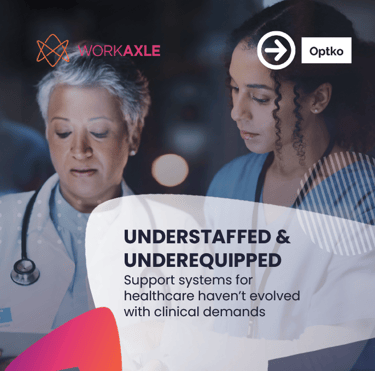
The Evolving Demands of Healthcare: The need for Agile Workforce Management Systems
This post discusses the need for modern workforce management solutions across the healthcare sector to increase staff moral, lower turnover and improve patient care.
WORKFORCE MANAGEMENT
6/1/20254 min read
Introduction
The healthcare sector is currently navigating a complex landscape characterised by a range of challenges associated with workforce management. Many healthcare organisations are grappling with understaffing, which significantly impairs their operational capacity and compromises the quality of patient care. This shortage of qualified personnel often arises from high turnover rates, an insufficient number of trained professionals entering the workforce, and budget constraints that limit hiring practices. As a result, healthcare facilities struggle to meet the clinical demands required to serve an expanding patient population effectively.
Moreover, these staffing challenges are exacerbated by a lack of digital technologies, relying on outdated manual processes, which is resulting in healthcare workers being unable to provide the necessary level of care. This is leading to increased frustration and potential burnout among staff. The pressure to deliver high-quality care in such an environment can overwhelm even the most dedicated professionals, thereby influencing retention rates and overall job satisfaction.
Effective workforce management is crucial for ensuring that healthcare organisations can respond dynamically to patient needs and evolving regulatory requirements. It involves strategic planning to optimise workforce deployment, training initiatives to enhance staff skills, and the implementation of digital technologies to streamline operational processes. As healthcare demands continue to evolve due to factors such as demographic shifts, increased prevalence of chronic diseases, and public health crises, organisations must prioritise the acquisition of highly agile workforce management systems. By addressing understaffing and equipping employees with necessary tools, healthcare providers can enhance both patient outcomes and employee satisfaction, ultimately contributing to a more stable and effective healthcare system.
The Gap Between Clinical Demand and Workforce Capabilities
The healthcare sector is currently witnessing a significant shift in clinical demands, largely driven by an increase in patient populations, the rise of global diseases such as Coronavirus, and rapid technological advancements in treatment. The rise in chronic conditions and an aging demographic necessitate a more flexible and responsive healthcare delivery system. As a result, healthcare providers are encountering unprecedented pressure to meet the diverse needs of patients, particularly in outpatient settings where demand has surged.
Traditional workforce management systems, however, struggle to accommodate these evolving clinical needs. These systems, often rigid and outdated, do not provide the agility needed to respond quickly to fluctuations in patient volume or the complexities of modern treatments. For instance, while telehealth has emerged as a valuable tool, many organisations lack the infrastructure to effectively integrate these services into their staffing models. Consequently, healthcare workers may be facing increased workloads without the corresponding support or resources they need to maintain quality care.
The ramifications of this gap between clinical demand and workforce capabilities extend beyond operational inefficiencies. A workforce that is continuously stretched thin may experience a decline in morale, leading to higher turnover rates and a lack of job satisfaction among healthcare professionals. Additionally, the potential for burnout looms large, threatening not just staff wellbeing but also patient outcomes. When healthcare providers are overwhelmed and unable to meet patient needs effectively, the quality of care diminishes, potentially resulting in poorer health outcomes for patients.
This evolving landscape underscores the critical need for healthcare organisations to invest in modern workforce management systems that can adapt to these changes. By doing so, they can reduce burnout, increase staff retention, and ultimately improve the quality of care delivered to patients.
Solutions to Address Workforce Management Challenges
As the demand for quality healthcare services continues to rise, innovative technological solutions are essential for enhancing workforce management systems. Advancements in predictive analytics, artificial intelligence (AI), and mobile applications are leading the charge in transforming how healthcare organizations effectively manage their human resources.
Predictive analytics plays a pivotal role in workforce management by analyzing historical data to forecast staffing needs. This proactive approach allows healthcare facilities to anticipate periods of high demand and adjust their workforce accordingly. For example, healthcare providers employing predictive analytics have successfully optimised staff schedules, thereby ensuring that the right number of healthcare professionals are available during peak times. This right sizing of staff across all hours of the day and throughout the week, can significantly improve patient care and staff morale.
AI-driven staffing solutions are also revolutionizing workforce management in healthcare. These systems can automate scheduling, taking into account various factors such as employee availability, skill sets, and shift preferences. By streamlining the scheduling process, healthcare organisations can reduce administrative burdens and minimize human error. Several studies have demonstrated that healthcare operators deploying AI-driven tools have experienced reduced staffing shortages and increased efficiency, leading to improved patient care outcomes.
Furthermore, mobile applications are empowering healthcare workers by providing them with easy access to vital information and tools directly from their smartphones. These applications enable staff members to manage schedules, request time off, and communicate with colleagues seamlessly. This enhances workforce engagement and ensures that healthcare workers feel supported and valued in a demanding environment.
Integrating innovative technologies into workforce management systems is essential for healthcare organisations can meet the demands of modern clinical needs while enhancing the overall effectiveness of their workforce management strategies.
Future Directions: Strategies for Evolving Workforce Management in Healthcare
The healthcare industry is undergoing significant transformation, necessitating a strategic evolution in workforce management systems to adequately address the current challenges. Adopting flexible staffing models is crucial to respond effectively to fluctuations in patient care demands. These models can include various arrangements such as hybrid staffing, on-call professionals, and telehealth services. By diversifying staffing strategies, healthcare organisations can mitigate the impact of understaffing and ensure they can meet patient needs without compromising on care quality. Flexibility enables healthcare facilities to adapt swiftly to changing conditions, thereby enhancing overall operational efficiency.
Optko understands the staffing challenges faced by the Healthcare sector and together with our Partners Workday and WorkAxle have developed solution specific for the needs of HealthCare providers.
To learn more download the brochure below or contact us at info@optko.io
B
Brochure: Workforce management for Healthcare providers.



